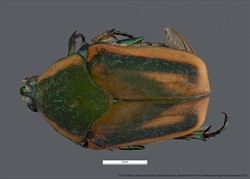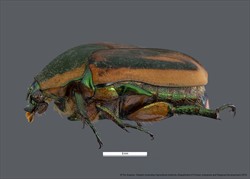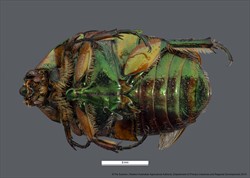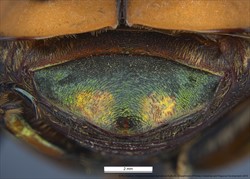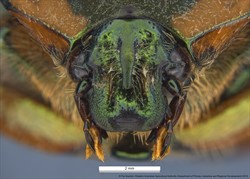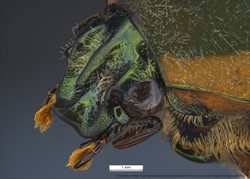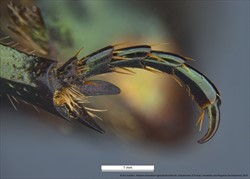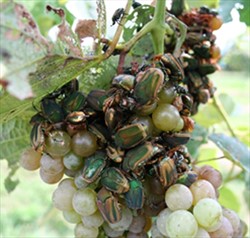Sub family: Cetoniinae / Tribe: Gymnetini / Genus: Cotinis
Fact Sheet
Cotinis nitida (Linnaeus, 1764)
Large dorsoventrally flattened beetles, body length: 15-27mm, 8.5-15.5mm wide. Dosal body (apart from shiny head) matte/velvet, colouration variable, usually green with tawny yellow areas. Body metallic green ventrally, occasionally copper. Hind femora pale, distinct from tibia and other ventral surfaces. Pronotum and elytra appearing completely smooth and lacking punctations. Pronotum projecting basomedially over the scutellum, nearly completely concealing it from view. Clypeus with apex emarginate/subquadrate, and bearing a frontal denticle (clypeal horn). Frons developed into a forward projecting longitudonal process. Mesepimeron visible from above. Posthumeral emargination of the eltra distinct. Forwardly projecting mesometasternal process present. Pygidium bicoloured, apical portion testaceous, basal portion green.
Commonly known as the Green June Beetle, adult Cotinis nitida beetles are known to feed on a wide range of thin skinned fruits including grapes, corn, apples, pears, peaches and berries. They are a recognised serious pest for the damage they cause both in larval and adult forms. They commonly have one generation per year, and can overwinter as mature larvae. They are slow flying, creating an audible buzz similar to a bumble bee.
Larvae are pests of pastures, hayfields, lawns and golf courses. The damage caused is through feeding on organic matter around the grass roots, disrupting the root/soil interface and limiting the plants ability to absorb water.
The presence of Popillia japonica has also been recorded as facilitating and increasing the pest status of Cotinis nitida. By feeding on intact grape fruits P. japonica in the United States have allowed fruit to be exploited by Cotinis nitida, whose mouthparts would have otherwise been unsuited to feed on the under ripe fruit (Hammons et.al. 2009). Injured fruit can also produce attractant volatiles causing potential for further fruit damage by increasing the number of beetles present.
Cotinis nitida is native and common through much of the Eastern United States, and west into Texas, Oklahoma and Kansas. It is absent from Australia.
Texas A&M Fact Sheet: http://agrilife.org/winegrapes/files/2015/11/GJB_factsheet.pdf
Brandhorst-Hubbard, J.L., Flanders, K.L., Appel, A.G. 2001. Oviposition site and food preference of the green June beetle (Coleoptera: Scarabaeidae). Journal of Economic Entomology 94(3): 628-633.
Goddrich, M.A. 1966. A revision of the genus Cotinis (Coleoptera: Scarabaeidae). Annals of the Entomological Society of America, 59(3): 550-568
Hammons D.L., Kurtural S.K., Newman M.C., Potter D.A. 2009. Invasive Japanese beetles facilitate aggregation and injury by a native scarab pest of ripening fruits. Proc Natl Acad Sci USA. 2009 Mar 10;106(10):3686-91. doi: 10.1073/pnas.0811097106.
Woodruff, R.E. 2008. The genus Cotinis Burmeister in the eastern United States, with description of a new species from the Florida Keys, including a checklist of the genus (Coleoptera: Scarabaeidae: Cetoniinae) Insecta Mundi 0051: 1-13

